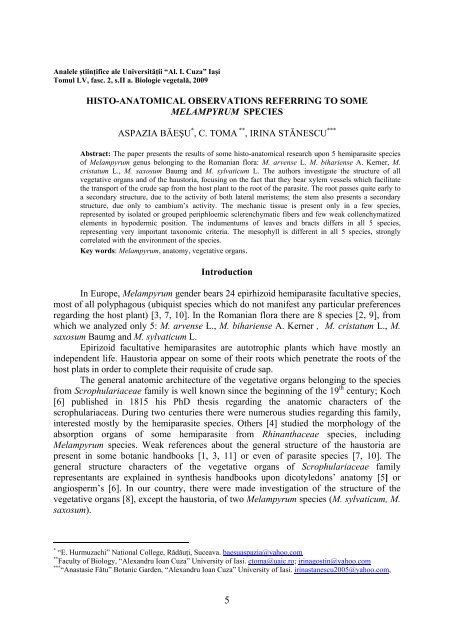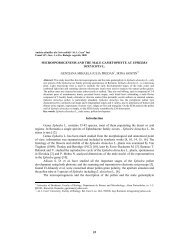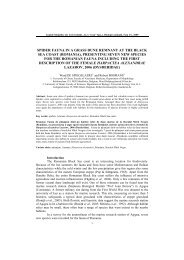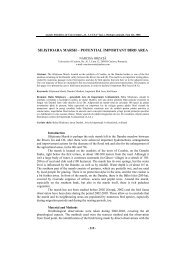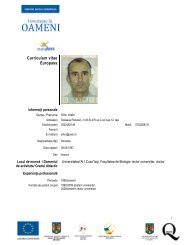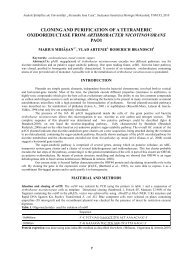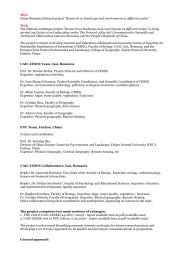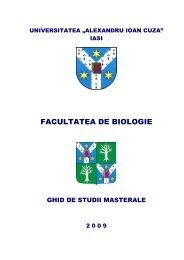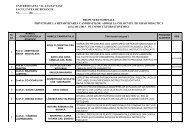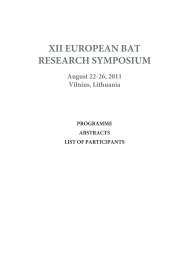Analele ştiinţifice ale Universităţii “Al - Facultatea de Biologie
Analele ştiinţifice ale Universităţii “Al - Facultatea de Biologie
Analele ştiinţifice ale Universităţii “Al - Facultatea de Biologie
You also want an ePaper? Increase the reach of your titles
YUMPU automatically turns print PDFs into web optimized ePapers that Google loves.
<strong>An<strong>ale</strong>le</strong> <strong>ştiinţifice</strong> <strong>ale</strong> <strong>Universităţii</strong> <strong>“Al</strong>. I. Cuza” Iaşi<br />
Tomul LV, fasc. 2, s.II a. <strong>Biologie</strong> vegetală, 2009<br />
HISTO-ANATOMICAL OBSERVATIONS REFERRING TO SOME<br />
MELAMPYRUM SPECIES<br />
ASPAZIA BĂEŞU * , C. TOMA ** , IRINA STĂNESCU ***<br />
Abstract: The paper presents the results of some histo-anatomical research upon 5 hemiparasite species<br />
of Melampyrum genus belonging to the Romanian flora: M. arvense L. M. bihariense A. Kerner, M.<br />
cristatum L., M. saxosum Baumg and M. sylvaticum L. The authors investigate the structure of all<br />
vegetative organs and of the haustoria, focusing on the fact that they bear xylem vessels which facilitate<br />
the transport of the cru<strong>de</strong> sap from the host plant to the root of the parasite. The root passes quite early to<br />
a secondary structure, due to the activity of both lateral meristems; the stem also presents a secondary<br />
structure, due only to cambium’s activity. The mechanic tissue is present only in a few species,<br />
represented by isolated or grouped periphloemic sclerenchymatic fibers and few weak collenchymatized<br />
elements in hypo<strong>de</strong>rmic position. The indumentums of leaves and bracts differs in all 5 species,<br />
representing very important taxonomic criteria. The mesophyll is different in all 5 species, strongly<br />
correlated with the environment of the species.<br />
Key words: Melampyrum, anatomy, vegetative organs.<br />
Introduction<br />
In Europe, Melampyrum gen<strong>de</strong>r bears 24 epirhizoid hemiparasite facultative species,<br />
most of all polyphagous (ubiquist species which do not manifest any particular preferences<br />
regarding the host plant) [3, 7, 10]. In the Romanian flora there are 8 species [2, 9], from<br />
which we analyzed only 5: M. arvense L., M. bihariense A. Kerner , M. cristatum L., M.<br />
saxosum Baumg and M. sylvaticum L.<br />
Epirizoid facultative hemiparasites are autotrophic plants which have mostly an<br />
in<strong>de</strong>pen<strong>de</strong>nt life. Haustoria appear on some of their roots which penetrate the roots of the<br />
host plats in or<strong>de</strong>r to complete their requisite of cru<strong>de</strong> sap.<br />
The general anatomic architecture of the vegetative organs belonging to the species<br />
from Scrophulariaceae family is well known since the beginning of the 19 th century; Koch<br />
[6] published in 1815 his PhD thesis regarding the anatomic characters of the<br />
scrophulariaceas. During two centuries there were numerous studies regarding this family,<br />
interested mostly by the hemiparasite species. Others [4] studied the morphology of the<br />
absorption organs of some hemiparasite from Rhinanthaceae species, including<br />
Melampyrum species. Weak references about the general structure of the haustoria are<br />
present in some botanic handbooks [1, 3, 11] or even of parasite species [7, 10]. The<br />
general structure characters of the vegetative organs of Scrophulariaceae family<br />
representants are explained in synthesis handbooks upon dicotyledons’ anatomy [5] or<br />
angiosperm’s [6]. In our country, there were ma<strong>de</strong> investigation of the structure of the<br />
vegetative organs [8], except the haustoria, of two Melampyrum species (M. sylvaticum, M.<br />
saxosum).<br />
* “E. Hurmuzachi” National College, Rădăuţi, Suceava. baesuaspazia@yahoo.com<br />
** Faculty of Biology, <strong>“Al</strong>exandru Ioan Cuza” University of Iasi. ctoma@uaic.ro; irinagostin@yahoo.com<br />
*** “Anastasie Fătu” Botanic Gar<strong>de</strong>n, <strong>“Al</strong>exandru Ioan Cuza” University of Iasi. irinastanescu2005@yahoo.com,<br />
5
Material and methods<br />
The studied species occupy various areas: M. arvense – cultures, crops, vineyards,<br />
bushes, from field to the mountain regions; the analyzed exemplars were collected from a<br />
lawn, Tulcea County; M. bihariense –lawns, bushes, bor<strong>de</strong>rs of forests, from hills to spuce<br />
level; the analyzed exemplars were collected from a lawn, Potoci, Neamţ County; M.<br />
cristatum –lawns and forest bor<strong>de</strong>rs, bushes, rockeries, from forest steppe to beech level;<br />
the analyzed exemplars were collected from the same lawn, Potoci, Neamţ County as M.<br />
bihariense. M. saxosum – forests and subalpine lawns; the analyzed material comes from<br />
Ceahlău Massive; M. sylvaticum –beech and spruce level, forests, rockeries, lawns; the<br />
investigated material was collected from a lawn, Red Lake.<br />
All material, collected in june 2004, has been fixed in ethylic alcohol 70%, sectioned<br />
(cross-sectioned and superficial) using a hand microtome and a cryotome, then it was<br />
coloured with ruthenium red and iodine green. The cuttings were mounted in gel and<br />
analyzed in a Novex (Holland) light microscope. The light micrographs were performed by<br />
a Minolta camera.<br />
Results and discussions<br />
The general structure characters are quite similar in all 5 analyzed species, the<br />
differences result from their various ecology, due to their different habitats.<br />
Lateral roots. The transition to the secondary structure is quite early, due to both<br />
lateral meristems: cambium and phellogen; even the thinnest roots present secondary<br />
structure in the central cylin<strong>de</strong>r (Fig. 1). The phellogen, differentiated due to an inner<br />
cortical layer, forms suber which exfoliates (Fig. 2). The phello<strong>de</strong>rm is represented by 1-2<br />
layers of cells with mo<strong>de</strong>rately thickened walls (M. arvense) or by a thin region with cells<br />
similar to those belonging to the secondary phloemic parenchyma (M. bihariense); most of<br />
it is often exfoliated, being present only in a few regions (M. cristatum, M. saxosum, M.<br />
sylvaticum) (Fig.3), so, the primary cortex, in most of the species, is exfoliated, excepting<br />
the primary endo<strong>de</strong>rmis; its cells present Caspary thickenings in the radiary walls (M.<br />
arvense); the endo<strong>de</strong>rmis of primary type presents strongly tangentially elongated cells in<br />
M.cristatum and is absent in M. bihariense.<br />
In the central cylin<strong>de</strong>r the following sub-regions and secondary tissues resulted from<br />
cambium’s activity can be distinguished:<br />
- an outer thin ring of phloem, formed by sieved tubes, guard cells and cells of<br />
phloemic parenchyma. In M. bihariense the proper conductive elements form<br />
small isles separated by cellulosed parenchyma (of phloem or of wi<strong>de</strong> medullary<br />
rays). The phloem ring is swept by one-layered or bi-layered parenchymaticcellulosed<br />
rays (M. cristatum); in M. saxosum the phloemic elements are strongly<br />
radiary flattened;<br />
- a central xylem massive, with vessels irregularly dispersed in the libriform; this is<br />
more <strong>de</strong>veloped in the external part of the secondary xylem, formed by<br />
tangentially-elongated elements, disposed on radiary rays; their walls are<br />
mo<strong>de</strong>rately thickened and lignified; only a few vessels and cells of xylemic<br />
parenchyma with mo<strong>de</strong>rately thickened walls are present in the center of the root.<br />
In M. saxosum 5 rays of vessels are displayed in the center of the organ; the<br />
6
elements present between the rays bear mo<strong>de</strong>rately thickened, but unlignified<br />
walls, representing libriform in progress.<br />
The main root. The structure is similar to that of the lateral root, with the following<br />
peculiarities:<br />
- at the periphery there could persist a thin region (often one-layered) of cells with<br />
weak thickened and suberified walls, which results from the activity of the<br />
phellogen differentiated from a profound cortical layer (Fig. 4);<br />
- phello<strong>de</strong>rm is well represented, multi-layered, bearing big cells with mo<strong>de</strong>rately<br />
collenchymatised walls in M. arvense and M. saxosum;<br />
- the ring of secondary phloem is thicker; there are groups of sclerenchymatic<br />
elements with mo<strong>de</strong>rately thickened and lignified walls in the center, periphery<br />
(M. arvense) and in the endo<strong>de</strong>rmis (M. cristatum);<br />
- the secondary xylem massive is quite thick, bearing a big quantity of libriform<br />
with numerous vessels of various diameter, irregularly dispersed (Fig. 5). In M.<br />
sylvaticum the central xylem massive presents an axial region with vessels<br />
separated by lignified parenchyma and an outer thicker region where the vessels<br />
are separated by numerous libriform elements, with strongly thickened and<br />
mo<strong>de</strong>rately lignified walls (Fig. 6). In M. bihariense, in the central part of the<br />
xylem massive there are two compact groups of smaller vessels, with strongly<br />
lignified walls, which represent rests of the primary xylem and tell us that the stel<br />
from the primary structure is of diarchic type (Fig. 7).<br />
Haustoria appear on the lateral roots and penetrate the root of other species (which<br />
belong to the same Melampyrum species or to other species). As a general form, the<br />
haustoria are spherical, with nodule-like profile.<br />
The root which forms haustoria has an asymmetric shape (at least regarding the<br />
central cylin<strong>de</strong>r) and the general structure is modified: the parenchymatic tissues (cortical,<br />
phloemic) prevail; the xylemic and phloemic tissues are weak <strong>de</strong>veloped (Fig. 8 and 9).<br />
Some cross sections of the main root display a longitudinal section of the haustoria,<br />
so, a cordon of tracheidal elements surroun<strong>de</strong>d by cellulosed parenchymatic cells could be<br />
distinguished (Fig. 10 and 11).<br />
The longitudinal section through the haustoria of M. cristatum evi<strong>de</strong>nces the direct<br />
contact between the cordon of xylem vessels of the haustoria and the xylem tissue of the<br />
main root. Xylem vessels bear mostly screw thickenings, surroun<strong>de</strong>d by long parenchyma<br />
cells, with weak thickened, but cellulosed walls. In M. sylvaticum the primary endo<strong>de</strong>rmis<br />
of the main root elongates in the haustoria. At the limit between the two partners (parasite<br />
and host), the cells of the haustoria present suberified and weak thickened walls; at the<br />
periphery of the haustoria almost all the cells are elongated, suchlike the root hairs, playing<br />
an important role in affixing on host’s root and penetrating it.<br />
The stem. In the superior part, the cross section has quadrate-rectangular profile,<br />
with roun<strong>de</strong>d angles (M. arvense, M. bihariense, M. cristatum, M. sylvaticum) or a<br />
hexagonal profile with roun<strong>de</strong>d angles and numerous hairs on two opposite si<strong>de</strong>s (M.<br />
saxosum) (Fig.12).<br />
In all 5 species, epi<strong>de</strong>rmis presents isodiametric cells of various dimensions, with<br />
the internal and external walls thicker than the others, the last one being covered by a thin<br />
cuticle; here and there, some multicellular unilayered protective hairs are present, bearing a<br />
narrowed terminal cell and very short multicellular secretory hairs, with unicellular pedicle<br />
7
and bicellular gland (in cross section), excepting M. arvese which does not bear any<br />
secretory hairs.<br />
The cortex is parenchymatic-cellulosed, of meatic type, formed by 3-7 layers of big<br />
cells with thin walls. Here and there, aeriferous lacunae are present in M. arvense and M.<br />
bihariense. The cortex does not present a special endo<strong>de</strong>rmis, while the central cylin<strong>de</strong>r<br />
does not present pericycle.<br />
The central cylin<strong>de</strong>r displays two rings of conductive tissue with primary origin in<br />
M. saxosum, M. sylvaticum and M. cristatum, with phloem formed by small isles of sieved<br />
tubes and guard cells and the xylem formed by vessels irregularly dispersed and separated<br />
by cells of cellulosed xylemic parenchyma; the rings are separated by a continuous multilayered<br />
thick region of procambial tissue (Fig. 13).<br />
In M. arvese and M. bihariense the transition to the secondary structure happens<br />
quite early, due only to the cambium. The secondary phloem bears cells of phloemic<br />
parenchyma, too, while xylem has vessels disposed on radial layers separated by libriform<br />
(Fig. 14).<br />
In the middle part of the stem, the structure differs as follows:<br />
- the protective hairs are more numerous in M. arvense and M. cristatum, less<br />
numerous in M. sylvaticum and M. bihariense; sometimes their shape is different,<br />
being very short and unicellular in M. bihariense;<br />
- numerous solitary or grouped sclerenchymatic fibers are present at the periphery<br />
of the phloem ring, bearing thick and lignified walls (M. bihariense);<br />
- the rings of conductive tissue (of secondary origin, in all analyzed species) are<br />
thicker than in the anterior analyzed level;<br />
- some species (M. cristatum, M. saxosum and M. sylvaticum) present aeriferous<br />
cavity, irregularly shaped, in the center of the pith, resulted by the disorganization<br />
of its cells; in M. bihariense, the medular region bear bigger cells, arranged in<br />
concentric layers, simulating a secretory canal (the cells will disorganize<br />
themselves in the inferior part of the stem in or<strong>de</strong>r to create the aeriferous cavity)<br />
(Fig. 15).<br />
In the inferior part of the stem we un<strong>de</strong>rline the following differences:<br />
- the protective hairs are less numerous, shorter and unicellular;<br />
- in M. arvense the epi<strong>de</strong>rmis is exfoliated somewhere, and some lenticels appear<br />
with a lot of spongy tissue (Fig. 16);<br />
- the cortical cells are tangentially elongated;<br />
- the ring of secondary xylem is thicker; all its elements present strongly lignified<br />
walls; in M. cristatum, three sub-regions can be distinguished in the xylem ring: an<br />
internal region with libriform mo<strong>de</strong>rately sclerified and numerous vessels, a<br />
middle one, with more libriform intensively lignified and only a few vessels and<br />
an external one, mo<strong>de</strong>rately sclerified and weak lignified (Fig. 17);<br />
- solitary or grouped sclerenchymatic fibers, with thickened and lignified walls are<br />
present at the outer part of the phloem ring;<br />
- pith is thin, partially disorganized, forming a big aeriferous cavity of irregular<br />
shape.<br />
The leaf. In M. arvense and M. cristatum the leaves are sessile, so our observations<br />
take into account the other 3 species.<br />
8
The petiole. In cross section, the petiole has a semieliptic-crescent profile, with<br />
concave adaxial face. Epi<strong>de</strong>rmis displays isodiametric cells, with the external wall thicker<br />
than the others and covered by a fine stripped cuticle; here and there, short unicellular or<br />
bicellular protective hairs are present. In the fundamental meatic parenchyma,<br />
collenchymatised in hypo<strong>de</strong>rmic position, phloemic-xylemic bundles of collateral type are<br />
present, of various number and position: numerous and closed one to another, disposed on a<br />
curved sheath and 1-2 far away from the others (M. bihariense); 3, with the middle one<br />
bigger than the others (M. saxosum) (Fig. 18); a wi<strong>de</strong> median arch with numerous bundles<br />
separated by uni- or multilayered parenchymatic rays and two lateral bundles (M.<br />
sylvaticum).<br />
The foliar limb. In front si<strong>de</strong> view, the epi<strong>de</strong>rmis displays cells of irregular shape,<br />
with strongly curved lateral walls; stomata of anomocytic type have various location: in<br />
both epi<strong>de</strong>rmis, so the foliar limb is amfistomatic (M. arvense and M. sylvaticum) or only in<br />
the lower epi<strong>de</strong>rmis, so the foliar limb is hypostomatic (M. bihariense, M. cristatum and M.<br />
saxosum). M. bihariense presents, in the lower epi<strong>de</strong>rmis, very big nectariferous extrafloral<br />
glands, located in <strong>de</strong>ep excavations; those glands bear numerous, radiary elongated,<br />
secretory cells which form a continuous sheath beneath the basal part.<br />
Both epi<strong>de</strong>rmis displays secretory and protective hairs, with different structure and<br />
position, as follows:<br />
- M. arvense: numerous protective hairs, mostly unicellular, but bi- or multicellular,<br />
too, bearing a basal cell of circular profile; they are longer at the lower part of the<br />
foliar limb and the point is flexed; very short protective hairs with thick wall and<br />
obtuse point, at the edge of the foliar limb; the secretory hairs are shorter, sessile,<br />
with bicellular gland in cross section;<br />
- M. bihariense: very short protective hairs, unicellular, rarely bicellular,<br />
aculeiform, oblique, narrow-pointed and with very thick walls; rare, short<br />
secretory hairs, with bicellular gland in cross section;<br />
- M. cristatum: numerous uni- bi- or multicellular protective hairs in both epi<strong>de</strong>rmis;<br />
rare multicellular secretory hairs;<br />
- M. saxosum: numerous short protective hairs, unicellular and mostly bicellular,<br />
located in the upper epi<strong>de</strong>rmis; numerous, short secretory hairs, with bicellular<br />
gland in cross section, more frequent in the lower epi<strong>de</strong>rmis;<br />
- M. sylvaticum: short, unicellular protective hairs, narrow-pointed, more numerous<br />
in the upper epi<strong>de</strong>rmis; multicellular secretory hairs, more frequent in the lower<br />
epi<strong>de</strong>rmis.<br />
In cross section of the foliar limb, the middle vein is very prominent at the abaxial<br />
face and consists of fundamental parenchyma and a vascular bundle or arch of condutive<br />
elements in M. bihariense (Fig. 19).<br />
The mesophyll could be: 1) weak differentiated in one-layered palisa<strong>de</strong> tissue with<br />
wi<strong>de</strong> and short cells and multilayered lacunary tissue, so the foliar limb has a bifacialheterofacial<br />
structure (M. arvense, M. cristatum and M. saxosum); the cells of the palisa<strong>de</strong><br />
tissue may have H form in M. saxosum and M. arvense (Fig. 20); 2) homogenous, of<br />
lacunary type, with the hypo<strong>de</strong>rmic adaxial layer bearing high and wi<strong>de</strong> cells, fact that<br />
makes us consi<strong>de</strong>r that the foliar limb presents a transitory structure from bifacial-izofacial<br />
to bifacial-heterofacial (M. sylvaticum); 3) homogenous, typical and entire lacunary, so the<br />
foliar limb has a bifacial-izofacial structure (M. bihariense).<br />
9
Conclusions<br />
The root passes quite early to the secondary structure, due to the activity of both<br />
lateral meristems. Only a few species present mechanic tissue, represented by isolated or<br />
grouped periphloemic sclerenchymatic fibers and a few weak collenchymatized elements in<br />
hypo<strong>de</strong>rmic position. Haustoria present a structure adapted to their function, bearing xylem<br />
vessels which facilitate the transport of the cru<strong>de</strong> sap from the host plant to the xylemic<br />
tissue of the parasite’s root.<br />
The stem presents a secondary structure resulted only from the cambium’s activity;<br />
the secondary conductive tissues are of annular type.<br />
The indumentums of leaves and bracts differs in all five species, being consi<strong>de</strong>red as<br />
very good taxonomic criteria. The mesophyll differs, too, in all five species, being<br />
correlated with the environment of the species.<br />
REFERENCES<br />
1. BONNIER G., SABLON L., 1905 - Cours <strong>de</strong> Botanique 1. Librarie Génér<strong>ale</strong> <strong>de</strong> l’Enseignement, Paris<br />
2. CIOCÎRLAN V., 2000 - Flora ilustrată a României. Bucureşti. Edit. Ceres<br />
3. GORENFLOT R., 1994 - <strong>Biologie</strong> végét<strong>ale</strong>. Plantes supérieurs. Paris. Edit. Masson: 184-193<br />
4. LECLERC DU SABLON, 1889 - Recherches sur les organes d’absorption <strong>de</strong>s plantes parasites. (Rhinanthées et<br />
Santalacées). Ann. <strong>de</strong>s Sci. Nat. Bot. 7 e série, 6: 91-117<br />
5. METCALFE C. R., CHALK L., 1972 - Anatomy of the Dicotyledons. Oxford, Clarendon Press. 2:1184-1194<br />
6. NAPP-ZINN KL., 1973, 1974, 1984 – Anatomie <strong>de</strong>s Blattes. II. Angiospermen. In Handbuch <strong>de</strong>r<br />
Pflanzenanatomie, Bd. VIII, 2 A1-2, 2 B1, Gebru<strong>de</strong>r Borntraeger, Berlin, Stuttgart<br />
7. NICKRENT D. L., MUSSELMAN L. J., 2004 - Introduction to Parasitic Flowering Plants. A. P. S. Education<br />
Center, Boston<br />
8. NIŢĂ MIHAELA, TUDOSE MIHAELA, GIUŞCĂ FL., 1995 - Contribuţii histo-anatomice referitoare la unele<br />
specii <strong>de</strong> Melampyrum L. Bul. Grăd. Bot. Iaşi. 5: 75-81<br />
9. PAUCĂ ANA, NYARADY E. I., 1960 – Melampyrum L. în Flora R. P. Române, Edit. Acad. Rom., Bucureşti,<br />
7: 622-639<br />
10. TOMA C., 2002 - Strategii evolutive în regnul vegetal. Iaşi. Edit. Univ. „Al. I. Cuza”<br />
11. TOMA C., GOSTIN IRINA, 2000 - Histologie vegetală. Iaşi. Edit. Univ. „Al. I. Cuza”<br />
Explanation of plates<br />
PLATE I<br />
Fig. 1 – Melampyrum arvense: lateral root (cross section)<br />
Fig. 2 – Melampyrum bihariense: lateral root (cross section)<br />
Fig. 3 – Melampyrum cristatum: lateral root (cross section)<br />
Fig. 4 – Melampyrum saxosum: main root (cross section)<br />
Fig. 5 – Melampyrum sylvaticum: main root (cross section)<br />
Fig. 6 – Melampyrum bihariense: main root (cross section)<br />
Fig. 7 – Melampyrum bihariense: main root (cross section)<br />
Fig. 8 – Melampyrum arvense: haustorul (cross section through the main root)<br />
Fig. 9 – Melampyrum sylvaticum: haustorul (cross section through the main root)<br />
PLATE II<br />
Fig. 10 – Melampyrum saxosum: haustorul (cross section through the main root)<br />
Fig. 11 – Melampyrum cristatum: haustorul (cross section through the main root)<br />
Fig. 12 – Melampyrum bihariense: tulpina (cross section)<br />
Fig. 13 – Melampyrum sylvaticum: stem (cross section)<br />
Fig. 14 – Melampyrum arvense: stem (cross section)<br />
Fig. 15 – Melampyrum bihariense: stem (cross section)<br />
Fig. 16 – Melampyrum arvense: stem (cross section)<br />
Fig. 17 – Melampyrum cristatum: tulpina (cross section)<br />
Fig. 18 – Melampyrum saxosum: peţiolul (cross section)<br />
Fig. 19 – Melampyrum bihariense: limbul (cross section)<br />
Fig. 20 – Melampyrum saxosum: limbul (cross section)<br />
10
ASPAZIA BĂEŞU and colabs. PLATE I<br />
Fig. 1 Fig. 2 Fig. 3<br />
Fig. 4 Fig. 5 Fig. 6<br />
Fig. 7 Fig. 8 Fig. 9<br />
11
ASPAZIA BĂEŞU and colabs. PLATE II<br />
Fig. 10 Fig. 11 Fig. 12<br />
Fig. 13 Fig. 14 Fig. 15 Fig. 16<br />
Fig. 17 Fig. 18 Fig. 19 Fig. 20<br />
12


